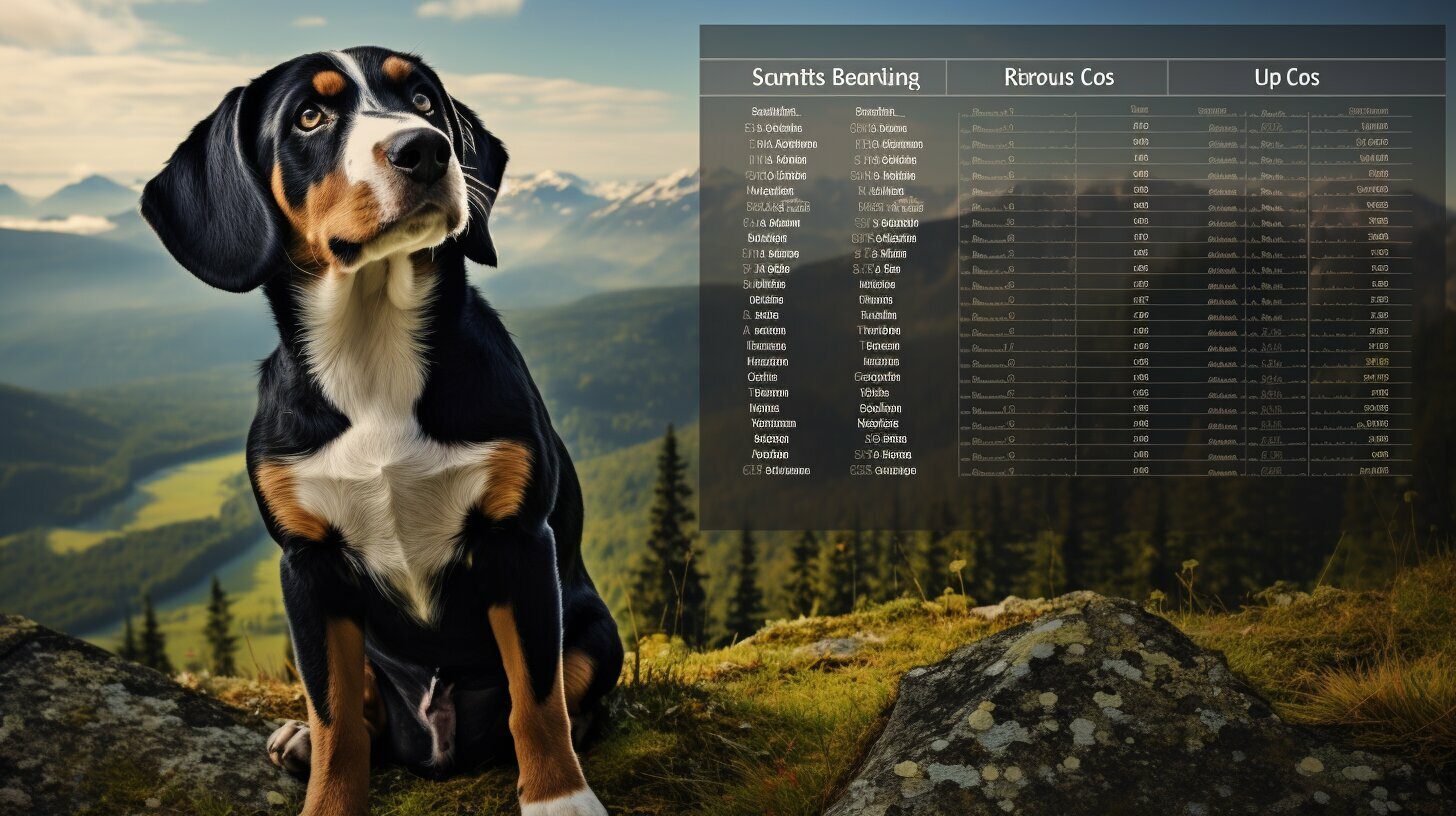
If you’ve ever wondered if dogs can safely consume bell peppers, you’re in the right place! In this guide, we’ll explore the world of bell peppers and their potential benefits for your furry friend.
Key Takeaways:
- Bell peppers are safe and healthy for dogs to eat.
- They are rich in vitamins A, E, B6, lutein, vitamin C, and beta-carotene.
- Introduce bell peppers slowly and in moderation.
- Remove seeds, stems, and avoid seasoning or salt.
- Spicy peppers, such as jalapeños or chili peppers, should never be given to dogs.
- Choose the right portion size based on your dog’s size.
- Consult with a veterinarian before introducing new foods into your dog’s diet.
Nutritional Value of Bell Peppers for Dogs
Bell peppers are not only colorful and delicious but also packed with essential nutrients that can benefit your dog’s well-being. Whether you feed them as a treat or incorporate them into their regular meals, bell peppers can provide a variety of health benefits for your furry friend.
One of the key nutritional benefits of bell peppers for dogs is their high content of vitamins and antioxidants. They are particularly rich in vitamins A, E, and B6, which play a crucial role in supporting your dog’s immune system and promoting overall health. Bell peppers are also a great source of lutein, vitamin C, and beta-carotene, which can contribute to your dog’s eye health and provide antioxidant properties.
When it comes to adding bell peppers to your dog’s diet, it is important to consider their dietary restrictions. While bell peppers are generally safe for dogs, some dogs may have difficulty digesting them or may be sensitive to certain components. It is recommended to introduce bell peppers slowly and in moderation, monitoring your dog’s reaction. Remove the seeds and stems before feeding them to your dog and avoid adding any seasoning or salt, as well as onions or garlic, which can be toxic to dogs.
Nutritional Value of Bell Peppers for Dogs
| Nutrient | Benefits |
|---|---|
| Vitamins A, E, B6 | Supports immune system and overall health |
| Lutein, Vitamin C, Beta-Carotene | Contributes to eye health and provides antioxidant properties |
The recommended portion size for dogs varies based on their size. Small dogs can have less than one-quarter of a bell pepper at a time, while larger dogs can have less than one-half of a bell pepper. It is always best to consult with a veterinarian to determine the appropriate portion size and to ensure that adding bell peppers to your dog’s diet aligns with their specific needs and overall dietary requirements.
Adding bell peppers to your dog’s diet can be a nutritious and tasty way to enhance their meals. However, remember to introduce them gradually, remove the seeds and stems, and avoid any potentially harmful ingredients. With the right approach, bell peppers can be a healthy addition to your dog’s diet, providing them with essential nutrients and contributing to their overall well-being.
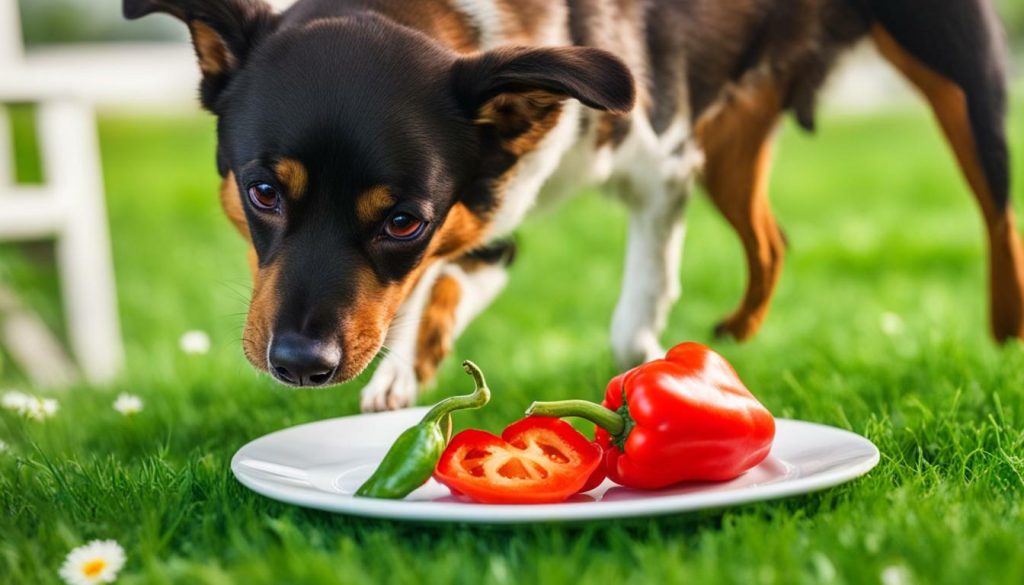
If you’re considering adding bell peppers to your dog’s diet, it’s important to do so gradually and with careful consideration. Bell peppers can be a nutritious addition to your dog’s meals, providing them with essential vitamins and antioxidants. However, some dogs may have difficulty digesting bell peppers, so it’s crucial to introduce them slowly and in moderation.
To incorporate bell peppers into your dog’s diet, start by selecting fresh, ripe peppers with vibrant colors. Red bell peppers are particularly beneficial as they contain higher levels of vitamins A, E, and lutein, which support your dog’s immune system and eye health. Before serving, remove the seeds and stems, as they can be difficult for dogs to chew and digest.
There are different ways to prepare bell peppers for your furry friend. You can feed them raw, as some dogs enjoy the crisp texture and natural taste. Alternatively, you can steam the peppers for a softer consistency that may be more appealing to your dog. Another option is to puree the bell peppers and mix them into your dog’s regular food or use them as a tasty filling for homemade treats.
When feeding bell peppers to your dog, it’s important to avoid seasoning, salt, onions, and garlic, as they can be harmful to dogs. Additionally, it’s crucial to remember that spicy peppers, such as jalapeños or chili peppers, should never be given to dogs as they can cause digestive upset and discomfort. Always consult with your veterinarian before introducing any new foods to your dog’s diet to ensure they are safe and suitable for your furry friend.
To summarize, bell peppers can be a nutritious and tasty addition to your dog’s diet when introduced gradually and in moderation. They provide important vitamins and antioxidants that support your dog’s overall health. Remember to choose fresh peppers, remove seeds and stems, and avoid seasoning or spicy varieties. By following these guidelines and consulting with your vet, you can safely incorporate bell peppers into your dog’s meals and offer them a variety of healthy and delicious options.
| Important Points to Remember When Feeding Bell Peppers to Dogs: |
|---|
| Start by introducing bell peppers gradually and in small amounts. |
| Select fresh, ripe bell peppers and remove the seeds and stems. |
| Avoid seasoning, salt, onions, garlic, and spicy peppers. |
| Feed bell peppers raw or steamed, or incorporate them into your dog’s regular food or homemade treats. |
| Consult with your veterinarian to ensure bell peppers are suitable for your dog’s specific dietary needs. |
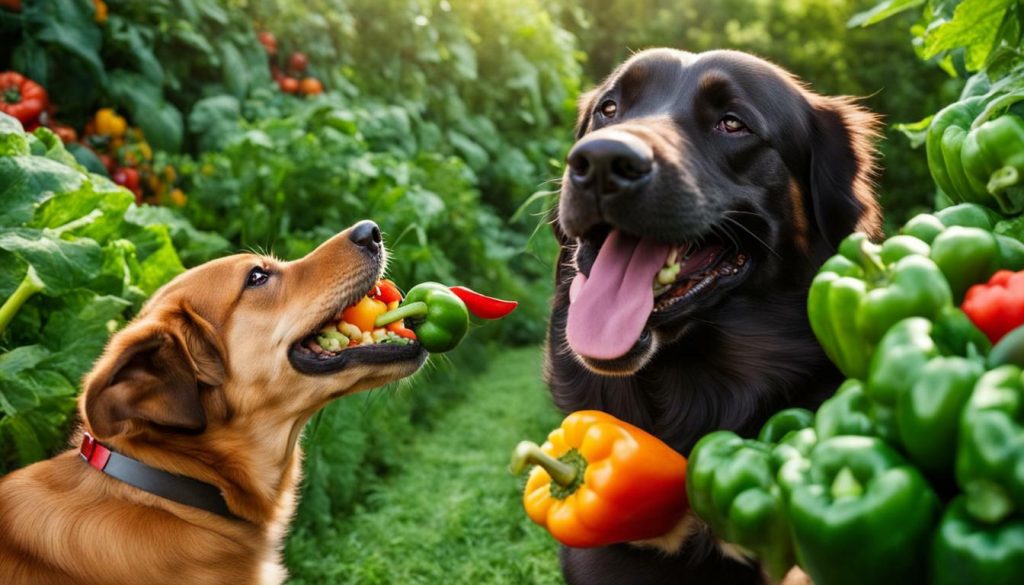
When offering bell peppers to your dog, it’s crucial to understand the differences between red, green, and yellow varieties and choose the most appropriate one for your pet. Each color has its own nutritional profile and varying levels of sweetness. Let’s take a closer look at the different types:
| Bell Pepper Color | Nutritional Benefits |
|---|---|
| Red | Red bell peppers are packed with vitamins A, E, and B6, as well as lutein. They are also the sweetest of the three colors, making them a favorite for most dogs. |
| Green | Green bell peppers are less sweet than red ones, but they are still a good source of vitamins A and C. They are also slightly crunchier, which some dogs may prefer. |
| Yellow | Yellow bell peppers have a mild and slightly sweet taste. They contain vitamins A, E, and C, as well as beta-carotene, which is beneficial for a dog’s immune system. |
While all three colors of bell peppers are safe for dogs to eat, it’s important to consider your dog’s preferences and any specific dietary needs they may have. Some dogs may prefer the sweeter taste of red bell peppers, while others may enjoy the crunchiness of green ones. Yellow bell peppers can be a good middle ground.
Remember to always wash the peppers thoroughly before offering them to your dog, and remove the seeds and stems to prevent any choking hazards. It’s also essential to feed bell peppers in moderation and monitor your dog for any adverse reactions. If you notice any digestive issues or allergies, consult with your veterinarian.
Summary:
- Bell peppers come in different colors, including red, green, and yellow, each with its own nutritional benefits and taste.
- Red bell peppers are the sweetest and packed with vitamins A, E, and B6.
- Green bell peppers are less sweet but still contain vitamins A and C.
- Yellow bell peppers have a mild taste and provide vitamins A, E, C, and beta-carotene.
- Consider your dog’s preferences and dietary needs when choosing the right bell peppers.
- Always wash peppers, remove seeds and stems, and feed them in moderation.
- If your dog experiences any digestive issues or allergies, consult with your veterinarian.
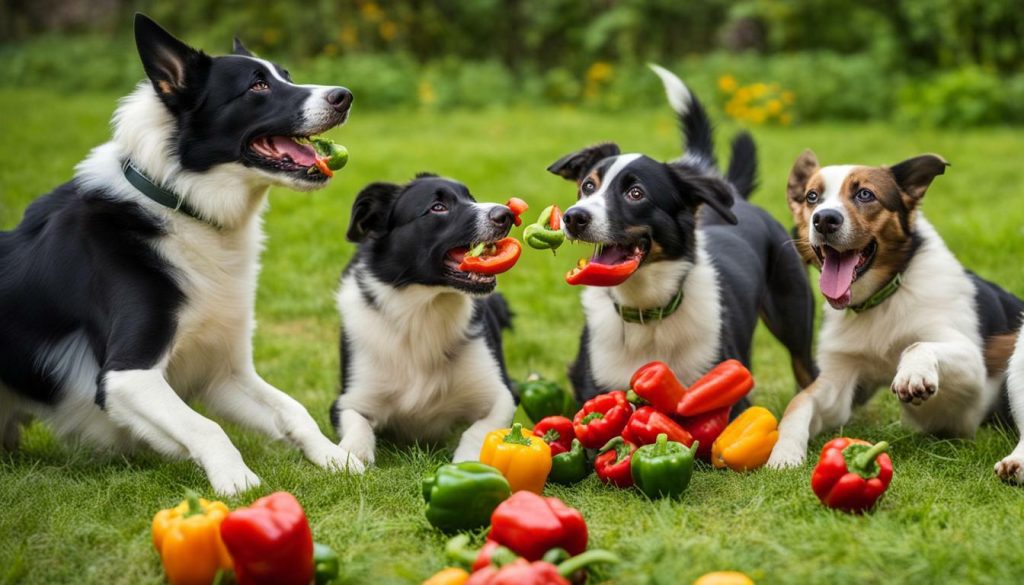
To ensure the safety and enjoyment of your dog while eating bell peppers, there are a few preparation steps you should follow. First, it’s important to choose fresh bell peppers that are free of any blemishes or signs of spoilage. Organic bell peppers are a great option as they are free from pesticides and other harmful chemicals.
Once you have chosen the perfect bell pepper for your dog, it’s time to prepare it for consumption. Start by washing the pepper thoroughly to remove any dirt or residue. Then, remove the stem and seeds from the pepper, as these parts can be difficult for dogs to digest…
“It’s crucial to remove the seeds and stems from bell peppers before feeding them to your dog,” says Dr. Emily Rodriguez, a veterinarian specializing in canine nutrition. “These parts can cause digestive issues and potential choking hazards.”
After removing the seeds and stems, you can choose to feed the bell pepper to your dog raw or lightly steam it. Steaming can help soften the pepper, making it easier for your dog to chew and digest. If you opt for steaming, be sure to let the pepper cool down before serving it to your furry friend.
| Dog Size | Recommended Portion |
|---|---|
| Small Dogs (up to 20 lbs) | Less than 1/4 of a bell pepper |
| Medium Dogs (20-50 lbs) | 1/4 to 1/2 of a bell pepper |
| Large Dogs (50+ lbs) | Less than 1/2 of a bell pepper |
Remember, moderation is key when feeding bell peppers to dogs. While they are a healthy addition to a balanced canine diet, too much of a good thing can upset your dog’s stomach. It’s always best to introduce new foods gradually and monitor your dog for any adverse reactions.
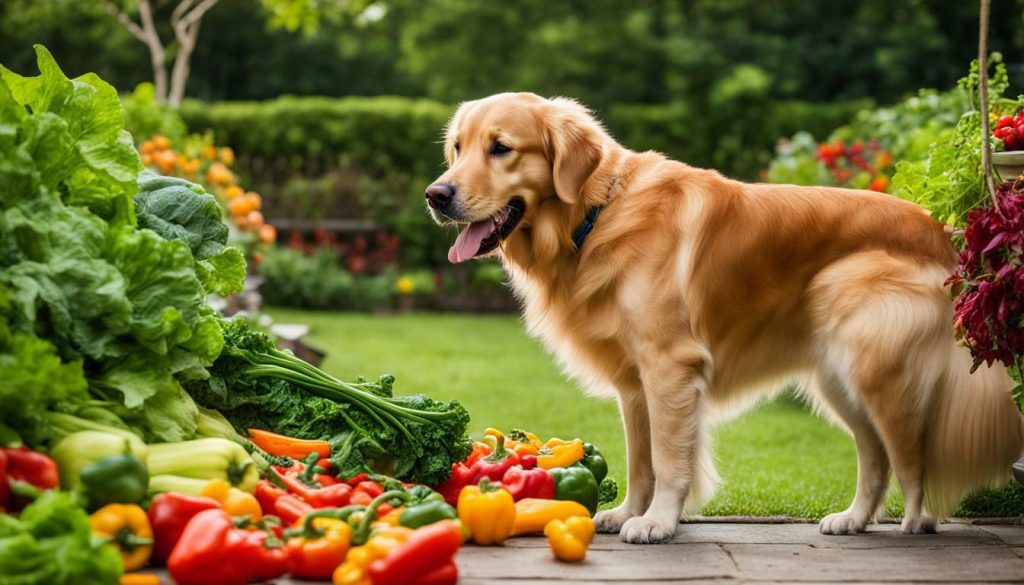
Feeding bell peppers to your dog can provide them with essential vitamins and nutrients, but it’s important to prepare and serve them properly. By following these preparation tips and portion guidelines, you can ensure a safe and enjoyable experience for your furry friend. Remember, if you have any concerns or questions about feeding bell peppers to your dog, it’s always best to consult with your veterinarian for personalized advice.
Raw or Cooked: Which is Better for Dogs?
When it comes to feeding bell peppers to your dog, you may be wondering whether raw or cooked is the better option. Both have their own advantages and considerations, so let’s explore the differences to help you make an informed decision.
Raw Bell Peppers: Raw bell peppers retain more of their natural nutrients, including vitamins and enzymes, which can provide additional health benefits for your furry friend. However, some dogs may find them difficult to digest, especially if they have a sensitive stomach. In such cases, it might be best to cook the bell peppers to make them easier to digest.
Cooked Bell Peppers: Cooking bell peppers can help break down the tough cellular walls, making it easier for dogs to digest and absorb the nutrients. The cooking process can also enhance the flavors, making them more appealing to some dogs. However, bear in mind that cooking may lead to a slight loss of certain nutrients, such as vitamin C. Still, the nutritional impact is generally minimal, and the health benefits are still present.
To ensure your dog receives the maximum nutritional benefits from bell peppers, you can try different methods of cooking, such as steaming or lightly sautéing. Avoid frying, as it adds unnecessary fats and oils to your dog’s diet.

Remember, whichever option you choose, it’s important to remove the seeds and stems from the bell peppers before feeding them to your dog. Additionally, always introduce new foods gradually and in moderation to monitor your dog’s response and ensure they don’t experience any digestive issues.
In summary, both raw and cooked bell peppers can be a healthy addition to your dog’s diet. Consider your dog’s individual needs and preferences, and consult with your veterinarian if you have any concerns or questions. By incorporating bell peppers in the right way, you can provide your furry friend with a nutritious and delicious treat.
Bell Peppers and Digestive Sensitivities in Dogs
While bell peppers are generally safe for dogs, it’s important to be aware that some canines may experience digestive sensitivities when consuming them. Just like humans, dogs can have individual dietary restrictions and may react differently to certain foods. In the case of bell peppers, some dogs may have trouble digesting them, which can lead to gastrointestinal issues such as an upset stomach, diarrhea, or gas.
If you notice any digestive issues after feeding your dog bell peppers, it’s best to consult with your veterinarian. They can help determine if your dog has an intolerance or allergy to bell peppers and recommend any necessary modifications to their diet. It’s always important to listen to your dog’s body and monitor their reactions to new foods.
When introducing bell peppers to your dog’s diet, start with small amounts and observe how they respond. Consider steaming or pureeing the peppers to make them easier to digest. Additionally, removing the seeds and stems before feeding them to your dog can help prevent potential digestive issues. By taking these precautions, you can help minimize the risks of digestive sensitivities while still allowing your dog to enjoy the nutritional benefits of bell peppers.
Table: Bell Peppers and Potential Digestive Sensitivities in Dogs
| Bell Pepper Color | Potential Digestive Sensitivities in Dogs |
|---|---|
| Red | May cause gastrointestinal discomfort in some dogs |
| Green | Can be easier to digest compared to other colors |
| Yellow/Orange | May cause gas or mild digestive upset in some dogs |
Remember, every dog is unique, and what works well for one dog may not suit another. Always consult with your veterinarian before making any significant changes to your dog’s diet or introducing new foods. With their guidance and monitoring your dog’s reactions, you can ensure a safe and balanced diet that includes the occasional treat of bell peppers.
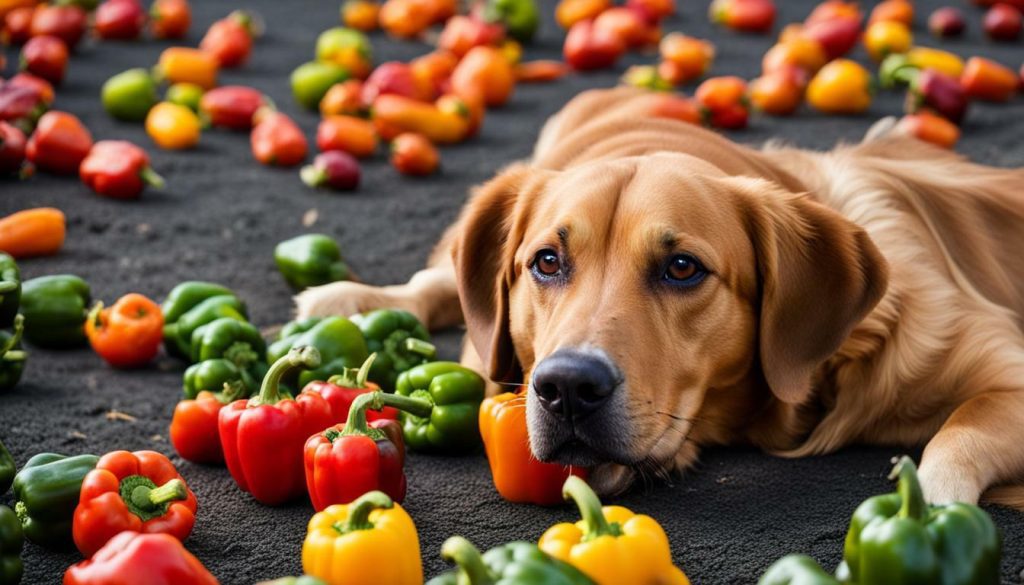
Just like with any new food, understanding the appropriate portion sizes for your dog when feeding bell peppers is crucial for their overall health. While bell peppers are safe for dogs to consume in moderation, it’s important not to overdo it. The recommended portion sizes depend on the size of your dog.
For small dogs, such as Chihuahuas or terriers, it is best to start with a small amount, such as a quarter or half of a pepper, and observe how they react. Monitor their digestion and watch for any signs of discomfort or digestive issues. If they tolerate it well, you can gradually increase the portion size.
For larger breeds, like Labradors or German Shepherds, you can offer them up to half of a pepper at a time. However, it’s still essential to introduce bell peppers slowly and watch for any adverse reactions. Every dog is different, and some may have more sensitive stomachs than others.
| Dog Size | Portion Size |
|---|---|
| Small | Quarter to Half of a Pepper |
| Medium | Half to One Pepper |
| Large | One Pepper or More |
Remember to always consult with your veterinarian before making any changes to your dog’s diet. They can provide personalized advice based on your dog’s specific needs and health conditions. Additionally, if you notice any unusual symptoms or digestive issues after introducing bell peppers, it’s crucial to seek veterinary guidance.

- Bell peppers are safe and healthy for dogs to eat in moderation.
- Introduce bell peppers slowly and observe your dog’s reaction.
- Remove seeds, stems, and avoid seasoning or salt when preparing bell peppers for your dog.
- The recommended portion sizes vary based on your dog’s size.
- Consult with your veterinarian for personalized advice and guidance.
Potential Health Benefits of Bell Peppers for Dogs
Beyond being a tasty treat, bell peppers can provide a range of health benefits for your four-legged companion. These vibrant vegetables, especially the red variety, are packed with essential vitamins and nutrients that can support your dog’s overall health and well-being.
Bell peppers are rich in vitamins A, E, B6, and lutein, all of which are beneficial for your dog’s immune system. Vitamin C and beta-carotene, also found in bell peppers, act as powerful antioxidants that can help protect your dog’s cells from damage caused by free radicals. Additionally, bell peppers contain fiber, which aids in digestion and can promote a healthy gastrointestinal tract.
| Nutrient | Benefits |
|---|---|
| Vitamin A | Supports eye health and promotes a strong immune system. |
| Vitamin E | Acts as an antioxidant and helps protect cells from oxidative stress. |
| Vitamin B6 | Assists in the production of red blood cells and supports brain function. |
| Lutein | Supports eye health and may reduce the risk of age-related eye diseases. |
| Vitamin C | Boosts the immune system and helps the body absorb iron. |
| Beta-Carotene | Converts to vitamin A in the body and supports immune function. |
To incorporate bell peppers into your dog’s diet, it is important to introduce them gradually and in moderation. Start by offering small pieces of bell pepper as a snack or mix them into your dog’s regular meals. Remember to remove the seeds and stems, as they can be difficult for dogs to digest. While bell peppers can be fed raw or steamed, some dogs may find them easier to eat when they are pureed. Always avoid adding any seasoning, salt, onions, or garlic, as these can be harmful to dogs.
When determining the portion size for your dog, consider their overall diet and size. Small dogs should eat less than one-quarter of a bell pepper at a time, while larger dogs can have less than one-half. It is important to monitor your dog’s reaction to bell peppers and consult with a veterinarian before making any significant changes to their diet.
By incorporating bell peppers into your dog’s diet, you can provide them with a delicious and nutritious snack that supports their immune system, promotes eye health, and contributes to their overall well-being.

While many bell peppers are safe for dogs to consume, there are certain varieties that should be avoided to ensure their well-being. The following types of bell peppers may pose risks and should be kept away from your furry friend:
- Spicy Peppers: Spicy varieties like jalapeños or chili peppers are a big no-no for dogs. They can cause gastrointestinal upset, discomfort, and even potential toxicity.
- Unripe Green Peppers: Unripe green bell peppers are harder to digest and may lead to stomach upset or diarrhea in some dogs. It’s best to opt for fully ripe peppers instead.
- Moldy or Rotting Peppers: Any bell pepper showing signs of mold or rot should be avoided as it can cause digestive issues and may even be harmful to your dog’s health.
Remember, even if a bell pepper is safe for dogs, always ensure you wash it thoroughly to remove any potential pesticides or harmful substances that could be present on the skin.
Feeding Bell Peppers Responsibly
When introducing bell peppers to your dog’s diet, it’s essential to do so responsibly. Start by offering a small portion and closely monitor your dog for any adverse reactions. If your dog shows signs of an upset stomach, vomiting, or diarrhea after consuming bell peppers, discontinue feeding them immediately and consult with your veterinarian.
Additionally, it’s important to vary your dog’s diet and not rely solely on bell peppers as a source of nutrition. Remember that bell peppers should only be given as an occasional treat and should not replace a balanced and complete dog food diet.
| Dog Size | Recommended Bell Pepper Portion |
|---|---|
| Small dogs | Less than one-quarter of a pepper |
| Medium dogs | Less than half of a pepper |
| Large dogs | Less than one-half of a pepper |
Please note that these portion sizes may vary depending on your dog’s individual dietary needs, age, and activity level. Always consult with your veterinarian to determine the appropriate portion and frequency of bell pepper consumption for your furry friend.

Before making any changes to your dog’s diet, it’s always best to consult with a trusted veterinarian who can provide personalized advice and guidelines. While bell peppers are generally safe for dogs to eat, every dog is unique and may have specific dietary needs or sensitivities that should be taken into consideration. A veterinarian will be able to assess your dog’s overall health and suggest the appropriate portion sizes and methods of incorporating bell peppers into their diet.
During a consultation with a veterinarian, you can discuss any concerns or questions you may have about feeding bell peppers to your dog. They can help determine if bell peppers are suitable for your dog based on factors such as age, breed, weight, and any existing health conditions. Additionally, if your dog experiences any digestive issues or allergic reactions after consuming bell peppers, a veterinarian will be able to provide guidance and recommend alternative options if necessary.
Remember, a veterinarian is an invaluable resource when it comes to your dog’s health and nutrition. They have the expertise and knowledge to ensure that any dietary changes are made safely and with your dog’s best interests in mind. By working together with your veterinarian, you can provide your dog with a balanced and nutritious diet that includes bell peppers and other beneficial foods.
| Consulting with a Veterinarian |
|---|
 |
Conclusion
To answer the question “Can dogs eat bell peppers?” with confidence, yes, they can, but it’s important to remember the necessary precautions and guidelines to ensure their well-being and enjoyment.
Bell peppers are safe and healthy for dogs to eat. They are packed with essential vitamins and nutrients that can support a dog’s immune system and overall health. The red variety, in particular, is rich in vitamins A, E, B6, and lutein, as well as vitamin C and beta-carotene.
When introducing bell peppers to your dog’s diet, do so slowly and in moderation. Some dogs may have difficulty digesting them, so it’s important to monitor their reactions. Remove the seeds and stems before feeding, as they can pose a choking hazard, and avoid adding any seasoning or salt, as well as onions or garlic, which are toxic to dogs.
It’s worth noting that spicy peppers, such as jalapeños or chili peppers, should never be given to dogs, as they can cause digestive discomfort and even harm. Bell peppers can be served raw or steamed, and if needed, they can be pureed to make them easier to consume.
The recommended portion size for dogs varies based on their size, with small dogs eating less than one-quarter of a pepper and large dogs eating less than one-half of a pepper at a time. However, it’s always best to consult with a veterinarian before introducing new foods into your dog’s diet to ensure it aligns with their specific needs.
In conclusion, bell peppers are a safe and nutritious addition to a dog’s diet. By following the proper guidelines and precautions, you can provide your furry friend with a tasty and beneficial treat. So go ahead, offer your pup some bell peppers, and watch them enjoy the health benefits these colorful veggies have to offer!
FAQ
Can dogs eat bell peppers?
Yes, bell peppers are safe and healthy for dogs to eat.
What are the nutritional benefits of bell peppers for dogs?
Bell peppers are rich in vitamins A, E, B6, lutein, vitamin C, and beta-carotene, which are important for a dog’s immune system and overall health.
How should I introduce bell peppers to my dog’s diet?
It is important to introduce bell peppers slowly and in moderation, and you should remove the seeds and stems. Consult with a veterinarian for specific guidance.
Can dogs eat spicy peppers like jalapeños or chili peppers?
No, spicy peppers should never be given to dogs as they can be harmful.
Should bell peppers be fed raw or cooked?
Bell peppers can be fed raw or steamed. Cooked peppers can be pureed to make them easier to consume.
How much bell pepper can I feed my dog?
The recommended portion varies based on your dog’s size, with small dogs eating less than one-quarter of a pepper and large dogs eating less than one-half of a pepper at a time.
Are there any bell peppers that dogs should avoid?
Dogs should avoid eating spicy bell peppers or any bell peppers that have been seasoned with onions or garlic, as these ingredients are toxic to dogs.
Can bell peppers cause digestive issues in dogs?
Some dogs may have difficulty digesting bell peppers, so it’s important to monitor their reactions and consult with a veterinarian if needed.
What are the potential health benefits of bell peppers for dogs?
Bell peppers can support a dog’s immune system, promote eye health, and provide antioxidant properties.
Should I consult with a veterinarian before feeding my dog bell peppers?
Yes, it is always best to consult with a veterinarian before introducing new foods into your dog’s diet to ensure it aligns with their specific dietary needs.


